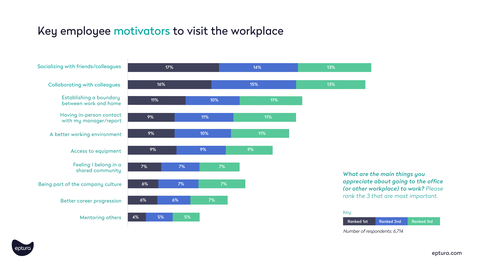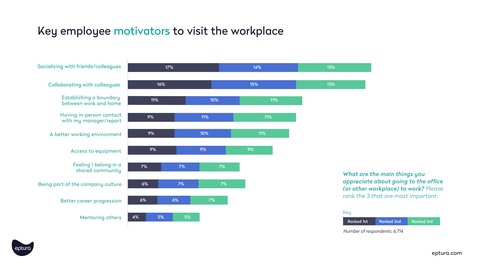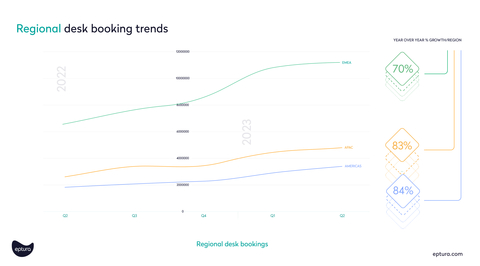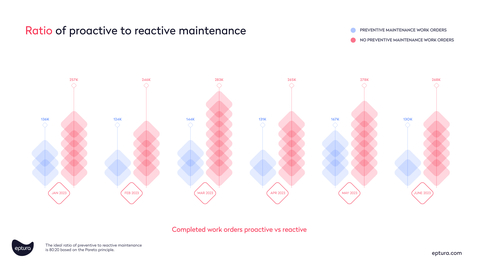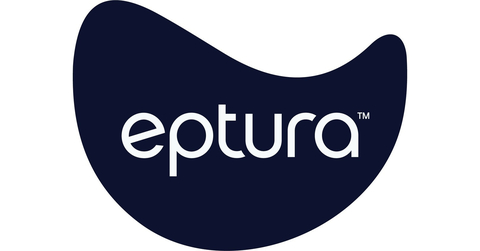ATLANTA--(BUSINESS WIRE)--Eptura, the global worktech leader, today released the latest edition of its quarterly Workplace Index which analyzes building use, asset data, and behavioral insights to provide a comprehensive view of the rapidly changing modern workplace. Key findings show a consistent yearly rise in workspace bookings and visitors across all regions and industry sectors alongside a 20% increase in maintenance work orders from Q2 2022 to Q2 2023.
Along with proprietary data including an analysis of 2.7 million desks, 37,000 buildings, and 440,000 floors across more than 8,000 companies, the Q2 index includes findings from a survey of 6,700 employees on workplace attitudes and behaviors. The report builds on insights from the Q1 Workplace Index across the competing priorities organizations are navigating in today’s workplaces and takes an in-depth look at the balance between employee freedom and the desire for connection. Findings reveal that the key driver for employees wanting to go into the office is the need for socialization and collaboration, acknowledging the desire to be part of a community and the isolation of working at home.
“Facility and asset managers continue to face significant challenges to identify the right workspace mix for employee needs while keeping their real estate and building systems running efficiently,” said Brandon Holden, CEO of Eptura. “We hear this from our customers worldwide, particularly as employee behavior continues to reinforce the need for flexibility. For organizations to make better investment decisions on their building assets, they must look beyond siloed data sources. Our quarterly Workplace Index analyzes operational data and qualitative feedback to uncover the macro trends that help inform long-range business planning.”
The report draws on a representative sample of Eptura’s global customer base to highlight emerging patterns in how the physical workspace operates at every level. Additionally, the survey included senior managers, middle managers, and individual contributors at businesses with at least 1,000 employees or more. Respondents came from the United States, United Kingdom, France, Germany, and Australia.
Connection leads the motivation for movement
Employees recognize the need for balance, acknowledging the isolation of working remotely and the need for social interaction. Asia-Pacific (83%), Europe, the Middle East and Africa (70%), and the Americas (84%) all saw significant year-over-year increases in desk bookings in Q2 2023.
According to the survey, senior managers and middle managers both rank collaborating with colleagues highest when asked what they appreciate most about going to the office. While socializing with friends and colleagues does not feature in senior managers’ top three motivations, it is the second-most important factor for middle managers. Individual contributors clearly crave connection, ranking socializing with friends and colleagues as their number one priority.
When asked where they like to work when in the office, 47% of survey respondents say they like to be near their team. This highlights that physical proximity to colleagues has a value beyond what employees feel they can achieve virtually. Matching this trend, meeting room bookings continued to increase steadily across regions and industries, pointing to an increased desire for connection and collaboration in the workplace. Year over year, APAC room bookings increased by 67% in Q2, EMEA increased by 57%, and the Americas increased by 48%.
Employee flexibility leads to workspace uncertainty
Workforces want full autonomy in choosing when they go into the office and the type of work they do there. While this fluidity is broadly welcomed by many companies, it affects the facility management and corporate real estate teams who must plan around erratic demand for workspaces and variable occupancy rates.
The report found that roughly a third of employees (33% in the Americas, 34% in APAC, and 31% in EMEA) book desks the day before or on the day they go into the office, resulting in much more complex planning for facility managers. This highlights the need for organizations to marry their employees’ desired workstyles and the need for predictability to paint a clearer picture of how a rising in-office population uses the modern workplace.
Cross-functional approach needed for facility management
Many companies are stuck at a crossroads – how can they optimize business premises to attract employees and visitors while simultaneously lessening burdens on the bottom line? While the report shows that monthly equipment inspections are rising month-over-month corresponding to more people being at the workplace, daily maintenance work orders closed tend to peak at the start of the week, with daily inspections peaking in the middle of the week.
To meet increased cost pressures, organizations must move away from siloed responsibilities to a cross-functional approach. Facility and asset managers, who traditionally work behind the scenes, need to work closely with front-of-house leaders to combine data analysis and decision-making. This will help companies efficiently manage assets and real estate portfolios to match demand while ensuring a cost-effective work experience that attracts employees to the office.
Flexible work patterns lead to flexible footprints
Business leaders are under immense pressure to reduce their CO2 emissions, especially with buildings accounting for 39% of global carbon emissions. However, leveraging flexible work patterns to optimize building systems — such as turning off lighting, heating, and cooling in targeted areas when not in use — offers less expensive ways for businesses to cut their carbon footprint.
By focusing on preventive rather than corrective maintenance, companies can make gains that can result in a significant reduction in CO2 emissions. While the ideal ratio of preventive to corrective maintenance is roughly 4:1, Eptura Q2 data shows a ratio of 4:7, meaning that for every four work orders planned, maintenance is responding to more than seven break-fix or other ad hoc ticket requests. By shifting the balance of maintenance activities from unscheduled to scheduled, organizations can optimize work based on building occupancy to meet sustainability goals.
To download the full Workplace Index Report by Eptura, please visit here.
About Eptura™
Eptura is a global worktech company that provides software solutions for people, workplaces, and assets to enable everyone to reach their full potential. With 16.3 million users across 115 countries, we are trusted by more than 16,000 of the world’s leading companies, including 40% of Fortune 500 businesses, to realize a better future at work. For more information, visit eptura.com.

